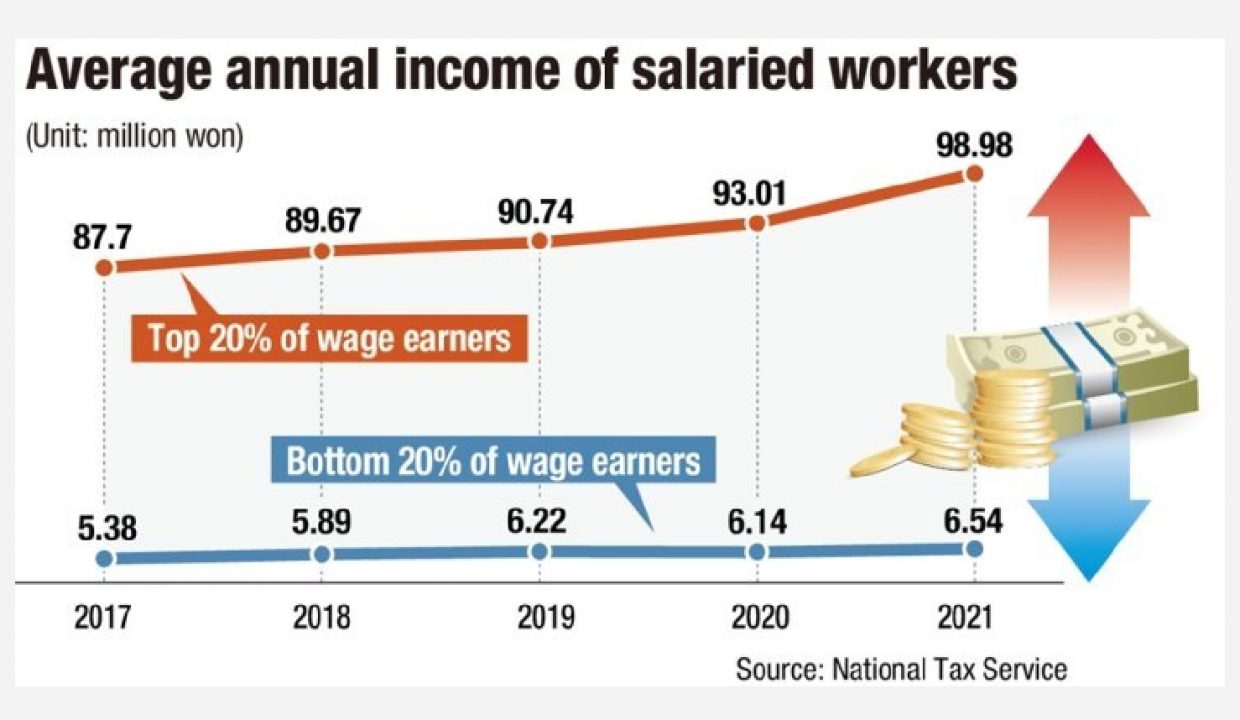
Income gap widening among workers
근로자 간 소득 격차 커져
Salaried workers’ income gap has been widening over the past couple of years amid the COVID-19 pandemic, data showed Wednesday.
수요일 발표된 자료에 따르면 지난 2년 동안 코로나19 팬데믹이 발생한 가운데 급여생활자의 소득 격차가 벌어진 것으로 나타났다.
The National Tax Service (NTS) submitted data to the office of Rep. Jin Sun-mee of the main opposition Democratic Party of Korea (DPK) showing that salaried employees in the top 20 percent bracket earned 15.1 times more than those in the bottom 20 percent between 2020 and 2021.
국세청이 국회 기획재정위원회 소속 더불어민주당 진선미 의원에 제출한 자료에 따르면 2020~2021년에 소득 상위 20%가 하위 20%보다 15.1배의 소득을 올렸다.
The figure reached 16.3 in 2017 and fell further to 14.6 as of 2019. But the widening gap started speeding up in 2020 when the pandemic lockdown started affecting every corner of the economy.
이 수치는 2017년에 16.3배에 이르렀고 2019년에는 14.6배로 떨어졌다. 그러나 팬데믹 제재가 경제의 모든 영역에 영향을 미치기 시작한 2020년에 격차가 커지기 시작했다.
“The government should adopt policies to reduce the gap between the income levels of each class, and help increase the overall wages of households,” Rep. Jin said.
진 의원은 “정부는 계층 간 소득격차를 줄이고 가계의 전반적인 근로소득 증대에 도움이 되는 정책을 도입해야 한다”고 말했다.
Despite the widening income gap, the range of salary increase in the bottom 20 percent bracket was bigger than that of the top group.
소득격차 확대에도 불구하고 소득하위 20%의 임금인상폭은 상위그룹의 임금인상폭보다 컸다.
The average salaries of those in the first quintile rose by 12.9 percent to 98.98 million won ($80,360) in 2021 from four years earlier. But they increased in the fifth with a sharper margin of 21.6 percent to 6.54 million won during the same period, data showed.
상위 20% 구간에 속한 고소득자의 평균 급여는 2021년 9898만원(8만360 달러)로 4년 전보다 12.9% 증가했다. 그러나 자료에 따르면 하위 20% 근로자의 근로소득은 같은 기간 654만원으로 21.6%의 급격한 증가를 보였다.
The average income for each salaried worker here reached 40.24 million won in 2021. This was the first time in history that the figure surpassed 40 million won. In 2017, each salaried worker earned 35.19 million won on average here. Those in the top 0.1 percent bracket received an annual income of 956.15 million won in 2021.
전체 근로소득자 1인당 평균 급여는 2021년 기준 4024만원이다. 근로자 평균 급여가 4천만원을 넘어선 것은 처음이다. 2017년 근로소득자 1인당 평균 소득은 3519만원이었다. 2021년 최상위 0.1%는 1인당 평균 연소득 9억5615만원을 벌었다.
The average salary of the upper 1 percent also came in at 317.3 million won, with the median worker earning 30.04 million won on average in the same year.
상위 1%의 1인당 평균 급여 역시 3억1730만원, 중간 지점인 상위 50%의 1인당 평균 급여는 3004만원으로 집계됐다.
“The salary growth has been driven by the sharper income rise for the medium to low brackets which benefited most from the minimum wage hike over the past four years,” Jin said.
진 의원은 “지난 4년간 근로소득 증가세는 최저임금 인상 수혜층을 비롯한 중•하위 계층의 소득 성장이 견인한 결과”라고 밝혔다.
Experts said the government should continue introducing diverse policies to reduce the household debt burden.
전문가들은 가계부채 부담을 줄이기 위해 정부가 다양한 정책을 계속 도입해야 한다고 전했다.

KEY WORDS
■ salary ~에게 봉급을 주다
■ gap 틈
■ bracket 계층[대]
■ quintile 5분위 수
■ margin 차이
■ surpass 뛰어넘다
■ drive (어떤 방향으로) 몰다
■ diverse 다양한
